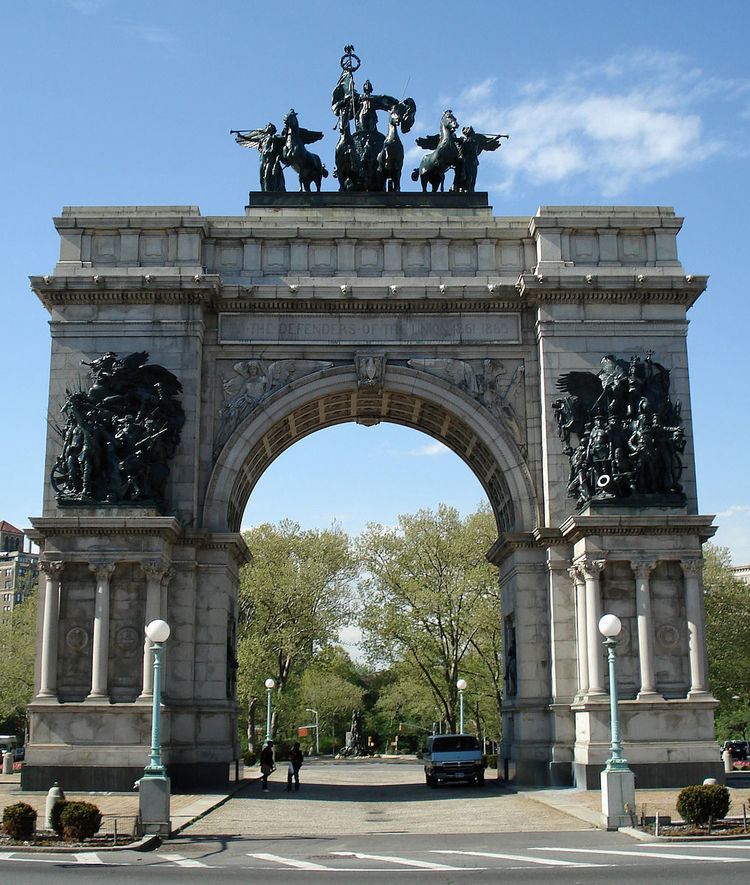- elevation 131 ft (39.9 m) Phone +1 718-965-8999 | Area 6 ha Architecture firm McKim, Mead & White | |
 | ||
Address Flatbush Ave, Brooklyn, NY 11238, USA Hours Closed today SaturdayClosedSundayClosedMondayOpen 24 hoursTuesdayOpen 24 hoursWednesdayOpen 24 hoursThursdayClosedFridayOpen 24 hours Similar Central Library, Prospect Park, Eastern Parkway–Brooklyn Museum, Soldiers' and Sailors' A, Prospect Park West | ||
Viewing nyc prospect park and grand army plaza
Grand Army Plaza, originally known as Prospect Park Plaza, is a public plaza that comprises the northern corner and the main entrance of Prospect Park in the New York City borough of Brooklyn. It consists of concentric oval rings arranged as streets, with the namesake Plaza Street comprising the outer ring. The inner ring is arranged as an ovoid roadway that carries the main street – Flatbush Avenue – with eight radial roads connecting: Vanderbilt Avenue; Butler Place; Saint John’s Place (twice); Lincoln Place; Eastern Parkway; Prospect Park West; Union Street; and Berkeley Place. The only streets that penetrate to the inner ring are Flatbush Avenue, Vanderbilt Avenue, Prospect Park West, Eastern Parkway, and Union Street.
Contents
- Viewing nyc prospect park and grand army plaza
- An extensive tour of brooklyn grand army plaza on bicycle part 34
- History
- Current use
- References
The plaza includes the Soldiers' and Sailors' Arch, the Bailey Fountain, the John F. Kennedy Monument, statues of Civil War generals Gouverneur K. Warren and Henry Warner Slocum, busts of notable Brooklyn citizens Alexander J.C. Skene and Henry W. Maxwell, and two 12-sided gazebos with "granite Tuscan columns, Guastavino vaulting, and bronze finials".
An extensive tour of brooklyn grand army plaza on bicycle part 34
History
Originally, the grounds of the Grand Army Plaza was a battleground of the Battle of Long Island, which was the first battle of the American Revolution.
The 1861 plan for Prospect Park included an elliptical plaza at the intersection of Flatbush and Ninth avenues. In 1867, the plaza was designed by Frederick Law Olmsted and Calvert Vaux as a grand entrance to the Park to separate the noisy city from the calm nature of the Park. Olmsted and Vaux's design included only the Fountain of the Golden Spray and the surrounding earth embankments covered in heavy plantings. The berms still shield the local apartment buildings and the main branch of the Brooklyn Public Library from the noisy traffic circle that has developed. By 1869 the Abraham Lincoln statue by Henry Kirke Brown was north of the plaza fountain's stairs, and the statue was moved to the lower terrace of the park's Concert Grove in 1895.
The original 1867 fountain was successively replaced by an 1873 lighted fountain, an 1897-1915 fountain for exhibitions, and the 1932 Bailey Fountain renovated in 2006.
In 1895, three bronze sculpture groups were added to the 1892 Soldiers' and Sailors' Arch. When the nearby 1896 Brooklyn Public Library was built, it was hoped that a new station on the BMT Brighton Line could be built almost directly under the building, but the $1 to 3 million cost was too much.
In 1926, the plaza, previously known as Prospect Park Plaza, was renamed Grand Army Plaza to commemorate the sixtieth anniversary of the foundation of the Grand Army of the Republic, a fraternal organization composed of veterans of the Union Army and other military services who served in the American Civil War.
In 1975, Grand Army Plaza became a National Historic Landmark.
In 2008, a competition was held for designs to reorganize Grand Army Plaza to make it a more integral part of Prospect Park and more accessible to pedestrians. At the same time, the New York City Department of Transportation (NYCDOT) made improvements in accessibility, putting sidewalks and planters in many of the striped areas. These improvements made it somewhat easier and safer for pedestrians and cyclists to cross from the park to the library and to the plaza. The changes made by the NYCDOT were modest in comparison to those in the designs in the competition, most of which called for the rerouting of some of the vast traffic flow.
Current use
The area around the Arch forms the largest and busiest traffic circle in Brooklyn, being the convergence of Flatbush Avenue, Vanderbilt Avenue, Eastern Parkway, Prospect Park West, and Union Street. In 1927, Brooklyn's "Death-O-Meter", a sign admonishing drivers to "Slow Up" and displaying a continually updated tally of traffic accident deaths in the borough, was installed.
For the past several years a popular green market/farmers market is held on the plaza in front of Prospect Park every Saturday from 8 a.m. to 4 p.m..
The Grand Army Plaza station (2 3 4 trains), built in 1920 on the IRT Eastern Parkway Line, is on the north end of the Plaza and furnishes transportation to the site and the nearby park. The Seventh Avenue station (B Q trains) on the BMT Brighton Line is several blocks northwest. The B67 and B69 buses stop at Union Street and 7th Avenue, just two blocks north.
